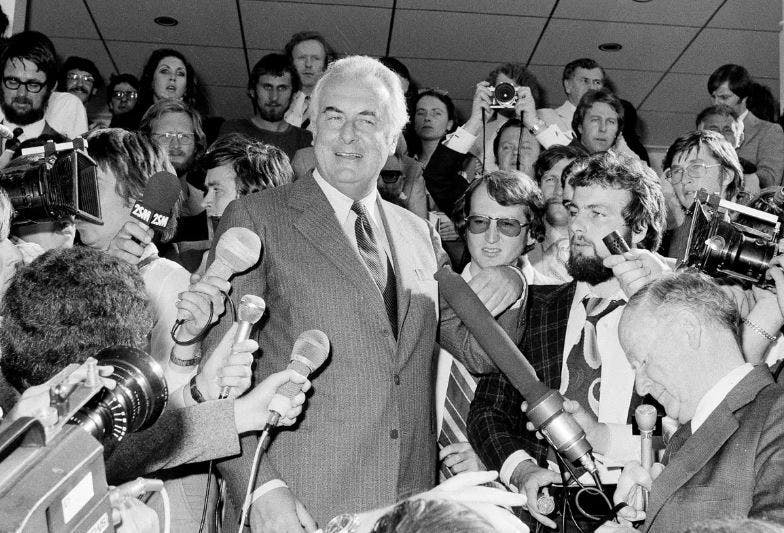The 'palace letters' and the coup against Whitlam: so much for democracy

The unelected Governor General Sir John Kerr secretly conspired for months to sack the twice-elected Whitlam government. This fact had been widely surmised. Now it has been confirmed by the release of the long-suppressed letters between Kerr and the Queen.
Kerr staged his coup on 11 November 1975 to install the arch reactionary Malcolm Fraser in office at the behest of an Australian ruling class determined to remove the Labor government. He did so despite the fact that the Queen’s secretary, Sir Martin Charteris, advised Kerr that there were other options to end the constitutional crisis, such as Kerr giving consent to the supply bill even if the Liberal dominated senate refused to pass it.
Why was the establishment so ready to dispense with the mask of democracy that normally disguises their class rule?
After 23 years in opposition, Labor had ridden to office in December 1972 on the back of a wave of radicalisation. Strike levels were skyrocketing as workers sought to gain their share of the postwar boom.
Rising working class militancy intersected with and reinforced a youth rebellion focused around opposition to conscription and the Vietnam War. Hopes of fundamental change were rising across the board.
Sections of the ruling class, including the Murdoch press, backed Labor in the hope that its mildly reforming agenda could both contain the revolt and modernise the economy.
Labor did manage to co-opt many of the social movements with a few hand outs and jobs for various careerists but was much less successful in curtailing worker militancy. The furious riot at the Ford Broadmeadows factory in June 1973 and the lengthy strike that followed was but one dramatic illustration of the growing working class assertiveness.
But in 1974 with the onset of recession, which heralded the end of the post war boom, the space for further reform evaporated. The ruling class now demanded that workers pay for the crisis.
Whitlam was happy to oblige. Huge hand outs were given to the big end of town.
Whitlam sacked leading left-wing ministers Jim Cairns and Clyde Cameron, and installed Bill Hayden as treasurer. Hayden went on to deliver a harsh austerity budget.
This, however, was not enough to satisfy the bosses, especially as Labor was having trouble winning the argument for austerity amongst its working class supporters. The ruling class craved a government of its traditional party – the Liberals – to carry through a full frontal assault.
Workers were disoriented by Labor’s attacks and the refusal of their union leaders to mount a concerted defence of their rights. But when Kerr struck to remove Whitlam they knew which side they were on.
Workers understood that much more was at stake than simply the survival of a Labor government. Kerr and behind him the capitalist class had declared class war.
The real tragedy of the coup was Labor’s refusal to fight. Kerr and his ruling class backers were only able to succeed in sacking Whitlam because the ALP establishment and the trade union leaders stifled the spontaneous wave of revolt that swept the country.
News of the coup immediately provoked furious anger. In workplace after workplace workers spontaneously walked out on strike.
The rebellion wasn’t just confined to the blue collar factory heartlands. As soon as they heard the news workers deserted the public service office where I was working in Melbourne and headed for the City Square.
An angry crowd of 8-10,000 gathered seemingly from nowhere and soon clashed with the cops. We set off for Liberal Party headquarters and stoned the building. Its smashed windows were not repaired for days afterwards as glaziers banned work on the office!
In Sydney protestors attempted to storm the Stock Exchange which had greeted the news of the coup with euphoria. Even quiet old Adelaide was rocked by street fighting.
The ruling class were increasingly and rightly worried. The military were put on full alert.
Rupert Murdoch’s Australian, which had campaigned for the sacking, stated in its editorial on 13 November that the demonstrations were “ominous” and raised “the very real danger that people might seek to express their opinions violently rather than democratically through the ballot box.”
On the same day in Sydney demonstrators marched on Murdoch’s Daily Mirror building to block the paper coming out. Papers were pulled off delivery trucks and burnt. Subsequently Murdoch’s own journalists went on strike in protest at the paper’s right wing editorial policy.
Enormous pressure was building for an all out general strike. But Bob Hawke, then head of the ACTU, pulled out all the stops to try stifle any action in order to save the day for Australian capitalism.
But the left union officials were under enormous pressure from their embittered rank and file and were forced to call a mass strike in Melbourne on Friday 14 November. At least 400,000 struck in Melbourne, and more strikes were underway in other cities. The basis was there for a sustained campaign to crush the coup.
That was the last thing the union leaders and ALP parliamentarians wanted. But the Labor leaders were totally incapable of calming the enormous angry crowd rallying in Melbourne. Instead, they had to turn to leading Communist union leader John Halfpenny.
Even Halfpenny was unable to prevent a massbreak away march that headed to the Melbourne’s stock exchange to vent their anger.
But with no socialist leadership to push forward the revolt, the strikes began to falter and the ruling class started to regain its confidence. The press went on the offensive. As the mass mobilisations fell off Labor ebbed sharply in the polls and Fraser was victorious in the subsequent election.
The Kerr Coup only succeeded because the Labor leaders were terrified by mass democracy in the streets. They preferred to lose office rather than be victorious on the back of a radical working class movement that was beginning to challenge the very fabric of capitalist rule.